
Guests
- Ryan Knutsonreporter who works with ProPublica and Frontline. His latest piece is titled BP Texas Refinery Had Huge Toxic Release Just Before Gulf Blowout
Just over three months ago, thousands of pounds of toxic chemicals began spewing into the skies from BP’s massive oil refinery in Texas City. The release began on April 6, two weeks before the explosion on the Deepwater Horizon oil rig, but it took BP weeks to even realize there was a problem. BP now estimates 538,000 pounds of chemicals escaped from the refinery over a forty-day period. We speak with reporter Ryan Knutson of ProPublica and Frontline, who traveled to Texas City to investigate what happened. [includes rush transcript]
Transcript
JUAN GONZALEZ: We now turn to look at a story about the oil giant BP that has received nearly no national attention. Just over three months ago, thousands of pounds of toxic chemicals began spewing into the skies from BP’s massive oil refinery in Texas City. The release began on April 6th, two weeks before the explosion on the Deepwater Horizon oil rig, but it took BP weeks to even realize there was a problem. BP now estimates 538,000 pounds of chemicals escaped from the refinery over a forty-day period.
AMY GOODMAN: The journalist Ryan Knutson of ProPublica and Frontline recently traveled to Texas City to investigate what happened. He joins us here in New York. His reporting on the story appears on the website ProPublica.org.
Welcome, Ryan. Tell us what you found.
RYAN KNUTSON: Thanks.
Well, we sort of went at this with the question of, well, you know, in 2005, BP had a disaster at this Texas City refinery, where fifteen people were killed. And after that event, you know, BP made — said it was a transformational event. They would make a lot of changes to the organization — or to their company. And the Deepwater Horizon happens. We wanted to examine, well, what was the lead-up to that explosion, and what has been the outcome of the promises to improve the company. And it didn’t take long to start finding that there has still been a lot of issues at the Texas City refinery. And most notably, what I thought was interesting was — and this was a story that was actually in the Daily News of Galveston County on June 5th, that hadn’t received any attention elsewhere, that there had been this 538,000-pound release.
And what happened in that circumstance was there was something called an ultracracker at this refinery, and it takes — it’s an important step in the process to produce gasoline. And there’s a hydrogen compressor on this ultracracker, and it broke down. And what it does is it captures a lot of the pollution that’s emitted from this, and it disposes of it safely. Now, when that broke down, BP had a choice: do we shut down the ultracracker and lose an important part of producing gasoline that we’d have to buy elsewhere or maybe reformulate the gasoline, or do we send everything to a flare and burn it off into the atmosphere? Now, flares, at best case, can destroy 98 percent of the chemicals that are sent to it. So two percent, they know, is going to release. At best case, there’s also studies that show that as much as 20 percent of what is sent to a flare doesn’t get destroyed and is sent off into the atmosphere.
So, they decided to send it to a flare, and it took them forty days to make the repairs. And once they were finished, by the time that they had finished analyzing all the data they had collected during the emissions event, they determined that 538,000 pounds of chemicals released into the atmosphere, most notably 17,000 pounds of benzene. Now, in the state of Texas, if you emit more than ten pounds in a twenty-four-hour period, you’re supposed to report that as an emissions event. In this case, 425 pounds of benzene were being released every twenty-four hours for forty days, ultimately leading up to 17,000 pounds.
JUAN GONZALEZ: And this is already a plant that has one of the highest benzene release rates in the country, isn’t it?
RYAN KNUTSON: Right, the Sierra Club did a study that, from looking at reportable emissions events from 1997 to 2007 and found that the Texas City refinery was the number one releaser of benzene in the United States. BP says that it has reduced its benzene emissions there by, I believe, 23 percent over each year, or 50 percent from last year. So the numbers have gone down significantly since that 2007 study was completed. But, as you know, environmental advocates make the case, well, there’s already a lot of benzene coming from that refinery, there’s a lot of benzene, because — in that Texas City community, because there’s a couple other refineries there. So it’s —-
JUAN GONZALEZ: And how is it possible for this release to go on for so long? You would assume that if they know that they were trying to burn some of these gases off with a flare, that they would have a likelihood of a potential for extra releases, that they’d be monitoring it on a daily basis.
RYAN KNUTSON: Right, and that’s the thing that I had a hard time pinning down from the BP people I spoke with, because I know that -— I mean, what they said originally is that they’ve got a method that’s approved by Texas regulators to monitor this along the way. And what they — I know that they have fence line monitors that are about six feet high, and so if there — if it reaches any sort of threshold, then it pages officials at the refinery, and they make a decision. And so, apparently, the fence line monitors didn’t go off. Now, the flare is 300 feet tall. So, clearly, this is going to kind of go out and sort of spread around. And so there’s various science about what the concentration is once it reaches the ground. It depends on the wind and things like that.
AMY GOODMAN: What does benzene do?
RYAN KNUTSON: Well, benzene is a known carcinogen. So it doesn’t necessarily have immediate — I don’t know — I mean, I imagine if you’re in a room full of it, you’d start coughing and wheezing and that sort of thing. But it’s proven that it will increase your cause — or your likelihood of getting cancer.
JUAN GONZALEZ: Especially leukemia, right?
RYAN KNUTSON: Yeah.
AMY GOODMAN: Last year, the Occupational Safety and Health Administration, OSHA, fined the company, BP, $87 million for failing to address safety problems from 2005, when they killed fifteen people.
RYAN KNUTSON: Yeah. So, yeah, in '05, they were — they settled with OSHA for $21 million, and they agreed to a number of improvements at the plant. And one of the main things that they agreed to is they were going to hire an independent auditor to come in and do an examination of the plant, point out things that need to be improved. OSHA says that BP should have made all those improvements by the end of 2009. BP says that it was under the impression that they just needed to have the auditor point these things out by September 2009 and that they could make these improvements as they made maintenance upgrades along the way.
AMY GOODMAN: Well, I wanted to go to the issue of the difficulty of reporting this. I want to bring in Lance Rosenfield, the freelance photographer hired by ProPublica to take pictures of BP's Texas City refinery. While on assignment, he was followed by BP security, then detained by local police. He joins us now from Austin, Texas.
Lance Rosenfield, welcome to Democracy Now! Describe what happened to you.
LANCE ROSENFIELD: Simply put, well, I was hired by ProPublica, like you said, to augment the story that Ryan is speaking of. And I was taking photographs. It was a two-day assignment, so I had various parts to cover, including basically giving a portrait of the town itself. So I had found a decorative “Welcome to Texas City” sign on a public highway south of town near the refinery. And, simply put, I was taking pictures of that sign. I pulled off the shoulder, like I would normally do, of the public street, walked over to the median, took the pictures, and then walked back to my car. And I was going to go back to my hotel to file the pictures, and I noticed that I was being followed by a security truck.
So, I needed gas, anyway. I didn’t feel like going — letting this guy, you know, follow me to my hotel. So I pulled into the gas station. He continued on, so I thought really nothing of it. Then police pulled in and essentially, you know, blocked me in as if I was going to try to go anywhere, and got out, asked who I was. They had got reports that I was taking photographs. And I said, “Yes, I’m a photojournalist.” And they said, “We need to see your pictures.” And I said, “Well, you know, without a warrant, I don’t feel like I need to show you the pictures.” And he said, “Well, we can — you can show them to us now, or we can do this later with Homeland Security,” sort of as a — it seemed to me like some sort of additional threat.
So, because I was on deadline, I made the decision to show them the pictures. I just wanted to get this over with. I knew I had nothing, you know, threatening on my photographs. I showed them the pictures, and he took my information. At this time, the security guard that was following me had turned back around, pulled into the parking lot. He was a BP security guard. And the BP security guard asked for my information, as well. And I declined, because he’s a corporate security guard. So he turned to the police officer who had just taken my information, including my Social Security number, and gave — I’m not sure exactly what of the information that the police officer took, what of that he gave to the BP officer, but he gave him whatever he needed.
And so, I protested. I said I didn’t understand, you know, why that was happening. I didn’t — I was never on BP property. And so, I asked, under what grounds was he able to share my information with a private corporation? And basically, I didn’t get a straight answer. I just got, “Well, this is Homeland Security procedure. We can call Homeland Security agent Tom Robison down here, you know, if you have a problem with it.” And I said, “Well, you know, I’m just trying to understand what legal grounds you have to do this, because I was never on BP property.” So he said, “Well, I’ll just call Tom Robison.”
So he called Tom Robison, who — at the time, I didn’t know who he was, of course. I’ve found out since that he’s a local police corporal who is the liaison to the FBI and Homeland Security, so — and he heads the local Joint Terrorism Task Force there in Texas City and, I guess, maybe the region. So — but at that time, I didn’t know who he was. They just referred to him as FBI and Homeland Security. They called Tom Robison. He actually gave me the phone, which I thought was a little unusual. But my natural reaction was to take the phone. Tom Robison got on the phone and asked me what my problem was. And I said, “Well, I’m just trying to understand why this is happening with BP getting my information.” He said, “You’re staying there. Don’t go anywhere until I get there.” And so, I gave the phone back to the police officer. He said, you know, “You need to stay.”
And at that point, I felt like, you know, the police officer had looked at my photographs on my camera. He had determined that there was no threat. And at this point, why was I being detained? It wasn’t clear to me, so — other than the fact that Tom Robison wanted to come down. So he showed up and basically approached me in a very, you know, antagonistic and aggressive manner. He was shaking. He was worked up. He was loud. He was boisterous. He asked what my problem was. He said his main concern was my attitude. And, you know, all I was trying to do was find out why BP was getting my information. And, you know, it was his antagonistic behavior that I had a problem with. I felt like he was harassing me. The BP security guard stepped in, and they both, you know, were trying to relate my activity as a photojournalist to terrorist activity, giving various scenario —-
JUAN GONZALEZ: And Lance?
LANCE ROSENFIELD: Yes.
JUAN GONZALEZ: Lance, was there any follow-up by ProPublica to find -— understand why this was happening or under what basis, because obviously if you had been with one of those automated cameras of Google in a car, just driving down the road taking photos, there wouldn’t have been any problem, would there?
LANCE ROSENFIELD: I guess not. You know, I don’t know. I mean, there was follow-up. And the statement that we got from BP said that they were following federal law. And there was another statement that BP followed up with, with once this sort of hit the blogosphere and airwaves, BP sent another reaction to ProPublica that gave the actual federal code that they were following. So, that was my answer. I mean, there was, in fact, a federal code that says BP is required by federal law to submit a report to the NRC. My question then is — and I’m not a lawyer, but my question then is, well, if I was never on BP property, and there were no infractions — I was not arrested —- then still, why was BP getting my information? And that, to me, is still unclear.
AMY GOODMAN: We’re going to leave it there, and we’re going to continue to follow this -—
LANCE ROSENFIELD: Sure.
AMY GOODMAN: — from Texas City to the Gulf of Mexico, where new rules have been laid down for journalists, making it much more difficult for photographers, videographers to get close to cleanup areas. This is an issue we’ll continue to cover. Lance Rosenfield, thanks for joining us, freelance photographer who was working for ProPublica, and Ryan Knutson, for your piece, the latest piece, “BP Texas Refinery Had Huge Toxic Release Just Before Gulf Blowout.”


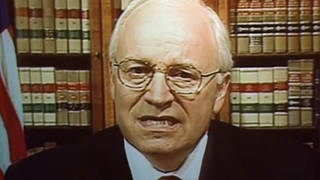
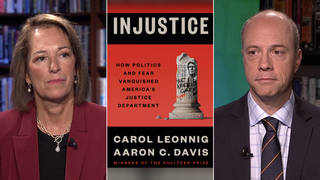
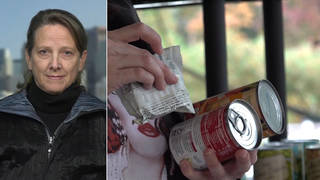





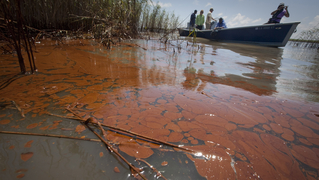
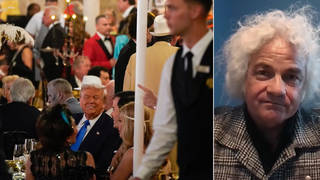
Media Options